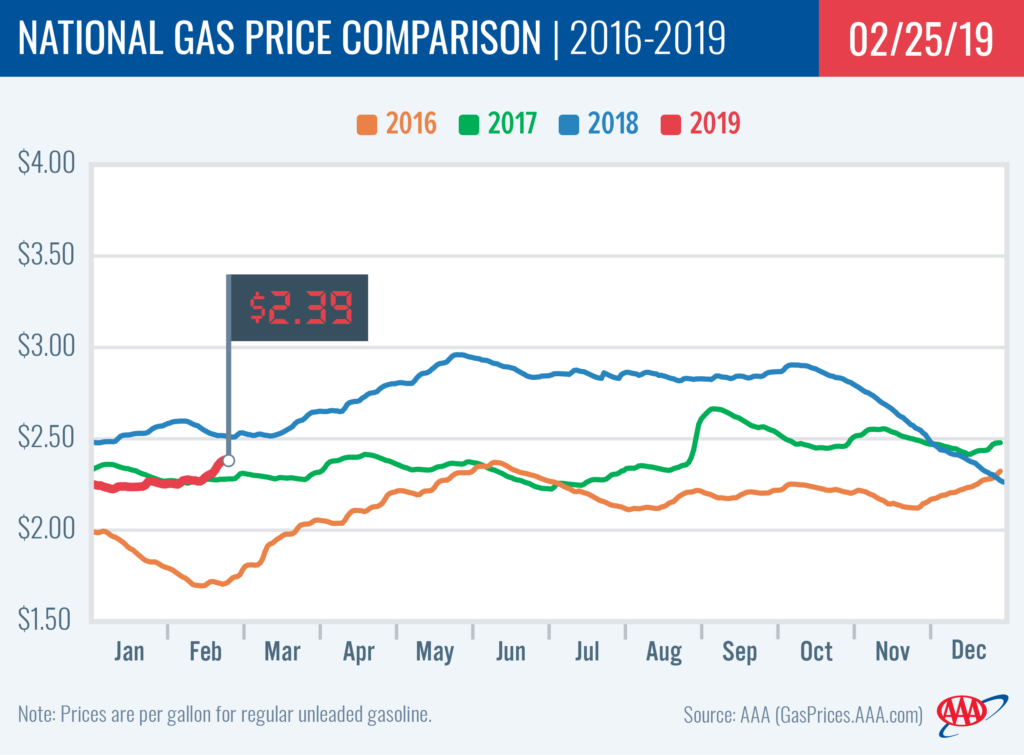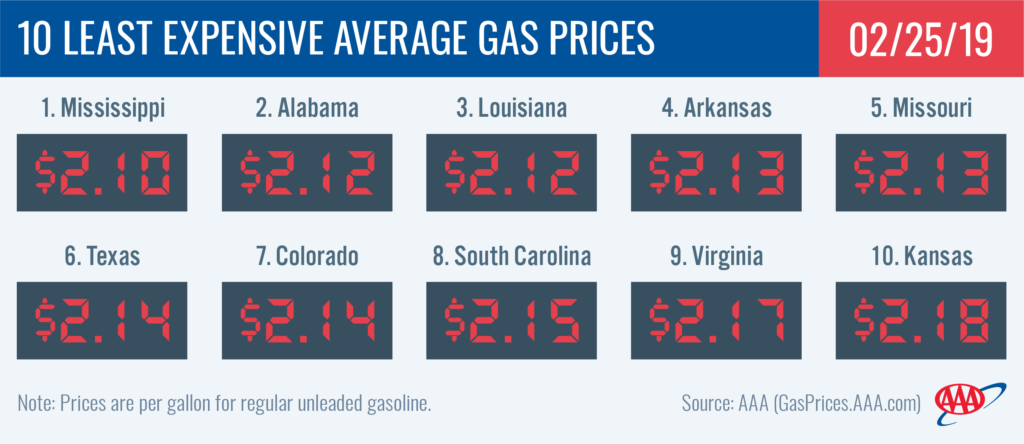Motorists can fill up for $2.50 or less at four in five gas stations throughout the country despite more than 40 states seeing gas price averages increase on the week. At $2.39, the national gas price average is eight cents more expensive than last week and 12 cents more expensive than last month, yet remains 12 cents cheaper year-over-year.
“On average, gas prices this year are 11 percent cheaper than the first two months of 2018 in part due to mostly cheaper crude oil prices so far this year,” said Jeanette Casselano, AAA spokesperson. “Even though pump prices are on the rise, the increase has been countered by mostly decreasing demand, leading to the majority of people still paying less than $2.50.”
Pump prices have increased around the country as refineries gear up for spring gasoline production and maintenance season.

Quick Stats
- The nation’s top 10 least expensive markets are: Mississippi ($2.10), Alabama ($2.12), Louisiana ($2.12), Arkansas ($2.13), Missouri ($2.13), Texas ($2.14), Colorado ($2.14), South Carolina ($2.15), Virginia ($2.17) and Kansas ($2.18).
- The nation’s top 10 largest weekly increases are: Minnesota (+15cents), New Mexico (+13 cents), Iowa (+12 cents), Indiana (+12cents), North Carolina (+11 cents), Nebraska (+11cents), Florida (+11 cents), Alabama (+11 cents), South Carolina (+10cents) and Illinois (+10 cents).

Great Lakes and Central
With gas prices increasing on the week as much as 15 cents in the region, Illinois ($2.45), Michigan ($2.41) and Indiana ($2.40) carry the most expensive state averages among Great Lakes and Central states. This week, Minnesota (+15 cents) saw the largest increase while Iowa and Indiana saw the second biggest increases at 12 cents, followed by Nebraska (+11 cents), Illinois (+10 cents) and Wisconsin (+10 cents).
Only four states in the country carry gas price averages more expensive than a year ago and two are from the Great Lakes and Central region. Motorists in Ohio (+3 cents) and Indiana (+2 cents) are paying two cents more a gallon to fill-up. Conversely, motorists in North Dakota (-30 cents) and South Dakota (-29 cents) are seeing the largest difference in the region compared to last year at this time.
With a 773,000 bbl build, regional inventories measure slightly above the 59 million bbl mark, according to EIA data. The region was just one of two in the country to see refinery utilization increase indicating that some refineries may have finished unplanned maintenance since January due to severe winter weather.
South and Southeast
Five South and Southeast states’ gas price averages jumped double-digits on the week: New Mexico (+13 cents), Florida (+11 cents), Alabama (+11 cents), South Carolina (+10 cents) and Mississippi (+10 cents). At $2.34, Florida touts the most expensive average in the region followed by Georgia ($2.28).
Following a week of substantial inventory growth, the latest EIA data reports that stocks drew down by 922,000 bbl for the South and Southeast, measuring total stocks just below 89 million bbl. It’s likely that the region will see gasoline supplies ebb and flow through April as regional refineries begin planned maintenance, which means the instability in stock levels is likely to push gas prices more expensive in the spring.

Mid-Atlantic and Northeast
North Carolina (+11 cents) was the only Mid-Atlantic and Northeast state to see gas prices jump double digits on the week, though three states saw a nine cent increase: Tennessee, Maine and West Virginia. All state averages are more expensive on the week with pump prices ranging from as expensive as $2.61 in Pennsylvania to as cheap as $2.18 in Tennessee.
A handful of regional states are among the few in the country who have cheaper gas prices today as compared to a month ago: Massachusetts (-3 cents), Vermont (-2 cents), Connecticut (-2 cents) and Rhode Island (-1 cent).
For a second week, the region saw a substantial drop in inventories. EIA reports the latest draw at nearly 2 million bbl. At 67.5 million bbl, stock totals are at their lowest since early January of this year, but sit at a 2.39 million bbl year-over-year surplus. In addition, refinery utilization dropped even further from 69.7 to 64 percent. Contributing to the reduced utilization is refinery maintenance at, but not limited to, PBF Energy 190,200 b/d in Delaware City, Del., Philadelphia Energy System (PES) 350,000 b/d in Philadelphia, Pa. and Phillips 66 Bayway 264,800 b/d in Linden, N.J.
Rockies
This winter, decreases at the pump have been the major trend for states in the Rockies region. With a three-cent decrease, Utah saw the second largest decrease of any state in the country on the week. Overall, the region’s gas prices are only more expensive than states in the South and Southeast region. Today’s pump prices in the Rockies are: Colorado ($2.14), Utah ($2.19), Wyoming ($2.25), Montana ($2.27) and Idaho ($2.28).
Utah (-21 cents), Wyoming (-13 cents) and Idaho (-12 cents) are among the minority of all states in the country who have gas prices cheaper than one month ago.
With a small draw of 46,000 bbl, EIA data shows stocks dipped below 7.5 million bbl in the Rockies region. The small draw combined with a healthy overall supply are helping to reduce any large fluctuation in pump prices for most of the region.
West Coast
Pump prices in the West Coast region are among the highest pump prices in the nation, with most of the region’s states landing on the nation’s top 10 most expensive list. At $3.28, California is the most expensive market. Hawaii ($3.26), Washington ($2.86), Nevada ($2.83), Alaska ($2.78) and Oregon ($2.74) follow. Arizona ($2.42) is the only state in the region that dropped from the 10 most expensive markets list. Prices in the region have mostly declined on the week, with Alaska (-4 cents) seeing the largest drop.
EIA’s recent weekly report showed that West Coast gasoline stocks are on the rise. They increased by approximately 700,000 bbl to 32.8 million bbl. However, stocks are approximately 1.4 million bbl lower than at this time last year, which could cause prices to spike if there is a supply challenge in the region this week.
Oil market dynamics
At the close of Friday’s formal trading session on the NYMEX, WTI increased 30 cents to settle at $57.26 – setting a new high for crude prices this year. If crude prices sustain at these higher levels, they could help send pump prices higher this spring. An increase in crude prices this week will likely be supported by optimism that the U.S. and China have been making significant strides to reduce trade tensions between the countries. However, crude price gains could be tempered by further increases in U.S. production, potentially signaling that the global crude market may be able to overcome an expected tightening in supply due to U.S-imposed sanctions on crude exports from Venezuela and Iran.
In EIA’s latest petroleum status report, the federal agency revealed that total domestic crude production hit 12 million b/d. This rate is the highest weekly estimate ever recorded by EIA, since it began tracking the data in 1983. Recent growth in domestic crude production helped to push up total domestic crude inventories by 3.7 million bbl to 454.5 million bbl last week.
In related news, Baker Hughes Inc. reported that the U.S. lost four oilrigs last week, bringing the total to 854. When compared to last year at this time, there are 54 more rigs this year.
Motorists can find current gas prices along their route with the free AAA Mobile app for iPhone, iPad and Android. The app can also be used to map a route, find discounts, book a hotel and access AAA roadside assistance. Learn more at AAA.com/mobile.
